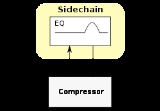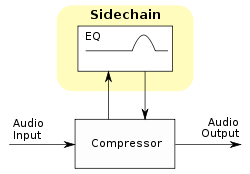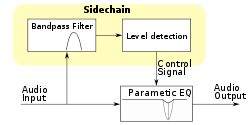
De-essing
Encyclopedia
De-essing is any technique intended to reduce or eliminate excess sibilant consonants such as "s", "z" and "sh" in recordings of the human voice. Excess sibilance can be caused by compression, microphone
choice and technique, and even simply a singer's mouth. Sibilance lies in frequencies anywhere between 2 kHz-10 kHz, depending on the individual.


 De-essing is a dynamic process, only working when the level of the signal in the sibilant range exceeds a set threshold. It differs from equalization
De-essing is a dynamic process, only working when the level of the signal in the sibilant range exceeds a set threshold. It differs from equalization
, which is a static change in level, but can also be used to reduce the level of sibilant frequencies.
De-essing can be achieved in the following ways, all perform the same function, temporarily reducing the level of high frequency content in the signal when a sibilant sound is present :
Side-chain compression or broadband de-essing: With this technique, the signal feeding the side-chain of a compressor is equalized or filtered so that the sibilant frequencies are most prominent. As a result the compressor only reduces the level of the signal when there is a high level of sibilance. This reduces the level over the entire frequency range.
As such, attack and release times are extremely important, and threshold settings cannot be placed as low as with other types of de-essing techniques without experiencing more blatant artifacts.
Split-band compression: Here, the signal is split into two frequency ranges, a range that contains the sibilant frequencies, and a range that does not. The signal containing the sibilant frequencies is sent to a compressor. The other frequency range is not processed. Finally the two frequency ranges are combined back into one signal. The original signal can be split into high(sibilant) and low frequencies, or, split so that the frequencies below AND above the sibilance are untouched. This technique is similar to multi-band compression.
Dynamic equalization: The gain of a parametric equalizer is reduced as the level of the sibilance increases. The frequency range of the equalizer is centered on the sibilant frequencies.
De-essing with automation: A more recent method of de-essing involves automating the level of the vocal in a DAW
. Whenever problematic sibilance occurs the level can be set to follow automation curves that are manually drawn in by the user. This method is not feasible without automation, as an audio engineer would not be able to react fast enough to reduce and restore vocal levels for only the split-second duration of the sibilant 's' or 't' sounds.
Microphone
A microphone is an acoustic-to-electric transducer or sensor that converts sound into an electrical signal. In 1877, Emile Berliner invented the first microphone used as a telephone voice transmitter...
choice and technique, and even simply a singer's mouth. Sibilance lies in frequencies anywhere between 2 kHz-10 kHz, depending on the individual.



Equalization (audio)
Equalization is the process commonly used in sound recording and reproduction to alter the frequency response of an audio system using linear filters. Most hi-fi equipment uses relatively simple filters to make bass and treble adjustments. Graphic and parametric equalizers have much more...
, which is a static change in level, but can also be used to reduce the level of sibilant frequencies.
De-essing can be achieved in the following ways, all perform the same function, temporarily reducing the level of high frequency content in the signal when a sibilant sound is present :
Side-chain compression or broadband de-essing: With this technique, the signal feeding the side-chain of a compressor is equalized or filtered so that the sibilant frequencies are most prominent. As a result the compressor only reduces the level of the signal when there is a high level of sibilance. This reduces the level over the entire frequency range.
As such, attack and release times are extremely important, and threshold settings cannot be placed as low as with other types of de-essing techniques without experiencing more blatant artifacts.
Split-band compression: Here, the signal is split into two frequency ranges, a range that contains the sibilant frequencies, and a range that does not. The signal containing the sibilant frequencies is sent to a compressor. The other frequency range is not processed. Finally the two frequency ranges are combined back into one signal. The original signal can be split into high(sibilant) and low frequencies, or, split so that the frequencies below AND above the sibilance are untouched. This technique is similar to multi-band compression.
Dynamic equalization: The gain of a parametric equalizer is reduced as the level of the sibilance increases. The frequency range of the equalizer is centered on the sibilant frequencies.
De-essing with automation: A more recent method of de-essing involves automating the level of the vocal in a DAW
Digital audio workstation
A digital audio workstation is an electronic system designed solely or primarily for recording, editing and playing back digital audio. DAWs were originally tape-less, microprocessor-based systems such as the Synclavier and Fairlight CMI...
. Whenever problematic sibilance occurs the level can be set to follow automation curves that are manually drawn in by the user. This method is not feasible without automation, as an audio engineer would not be able to react fast enough to reduce and restore vocal levels for only the split-second duration of the sibilant 's' or 't' sounds.

